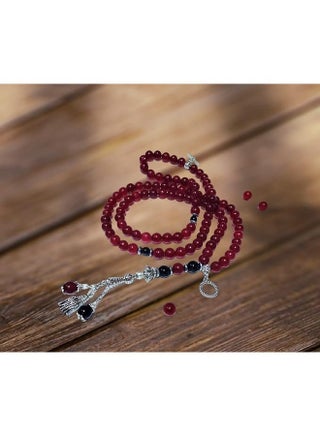The rosary features 99 beads, also known as tasbih beads or subha beads, which are usually made of materials such as wood, plastic, glass, or semi-precious stones. These beads are typically arranged in groups of 33, with each group separated by a marker bead or space.
Color:
The beads are specifically red in this instance, though rosaries come in various colors and materials. Red may hold symbolic significance, representing themes such as passion, sacrifice, or martyrdom, depending on cultural or religious interpretations.
Pendant:
At the end of the rosary, there is often a pendant or tassel. The pendant can vary widely in design, ranging from simple to elaborate, and may feature religious symbols, inscriptions, or decorative motifs.
Significance:
The 99 beads of the rosary correspond to the 99 names or attributes of Allah (God) in Islamic tradition. Reciting these names, known as the "Asma al-Husna," holds spiritual significance and is a form of dhikr (remembrance) and devotion. Each bead is touched or moved as the practitioner recites one of the names, guiding them through the meditative practice.
Prayer Practice:
Using the rosary, believers engage in the practice of dhikr, where they repeat the names of Allah or other prayers and supplications. This practice is a way to deepen one's connection to the divine and cultivate mindfulness and spiritual awareness.
Cultural Variations:
While the 99-bead rosary is commonly associated with Islamic practice, variations exist in different cultures and religious traditions. For example, the Catholic rosary typically consists of 59 beads arranged in a specific pattern, with additional beads for other prayers.
Overall, a red rosary consisting of 99 beads with a pendant is not only a religious accessory but also a symbol of devotion, spirituality, and contemplation within the Islamic tradition.
Free & Easy Returns
Best Deals

